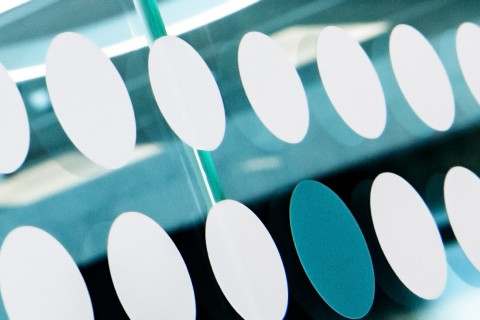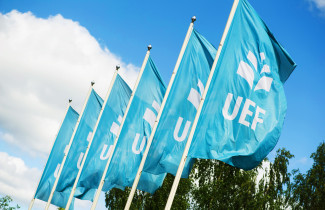The doctoral dissertation in the field of Applied Physics will be examined at the Faculty of Science and Forestry on the Kuopio Campus.
What is the topic of your doctoral research?
The research focuses on adsorption technology aiming at developing a novel adsorbent to selectively recover scandium and uranium from dissolved multi-metal solutions. Scandium is used in several applications such as in solid oxide fuel cells and scandium-aluminum alloys, but its wider utilization is restricted due to its scarcity and high price. Scandium is rarely found in any appreciable concentrations in ores, and hence, it is mainly produced from secondary resources such as mine-tailings from the processing of other metals.
However, it is very difficult to efficiently extract scandium because it exists at a lower concentration than other metals dissolved in the tailing solutions. Therefore, novel methods are needed that could efficiently recover scandium from these resources to supply the high technology industry with scandium at a reasonable cost. Uranium is a radioactive and highly toxic metal. Its exposure even at trace amounts is harmful to humans e.g., causing kidney failure. Uranium contamination in groundwater from mining, processing, and disposal of uraniferous resources is prone to pollute the environment e.g., they may end up in wells used for drinking water. Therefore, it is important to remove uranium from wastewaters to prevent it from contaminating the environment and the recovered uranium needs to be stored safely to secure public health.
What are the key findings or observations of your doctoral research?
Adsorption is a sustainable method to extract, concentrate and purify metals from aqueous solutions, because of low energy consumption and scalability. However, to be economically viable and truly sustainable, the adsorbent needs to be selective towards targeted metals and needs to be reusable for several tens or hundreds of adsorption/desorption cycles.
The developed adsorbent is based on a nanostructured hybrid material that is made up of bisphosphonate molecules functionalized on carbonized surfaces of mesoporous silicon. The bisphosphonates were mainly responsible for the metal adsorption properties of the material whereas the carbonized mesoporous silicon substrate maintained the stability of the adsorbent to allow its reutilization. The material’s capacity to adsorb the metals was dependent on the pH of the metal solution such that the adsorption capacity was two times greater at pH 3 than at pH 1. Because of the good binding affinity of bisphosphonate with scandium and uranium, the adsorbent was exemplarily selective towards scandium and uranium than other metals dissolved in processed ore solutions.
Noteworthily, the adsorbent depicted superior selectivity towards scandium in comparison to a commercial adsorbent. By using the developed adsorbent, it was possible to efficiently desorb the adsorbed uranium in a small volume where the concentration of uranium was increased by 15 times in comparison to the original solution. The collection of uranium in a small volume is beneficial as it allows the uranium-contaminated wastewater to be stored safely. Crucially, the developed adsorbent was effectively reused up to 50 adsorption/desorption cycles without any essential depreciation in the performance.
How can the results of your doctoral research be utilised in practice?
The framework of the present research lies within the scope of circular economy to recover scandium from secondary resources such as the mine tailings. The results of the research can also be utilized in limiting the release of toxic uranium into nature to secure public health and guarantee environmental safety. The adsorbent developed consisted of a nanoporous framework that enhanced the water permeability for its use in a flow-through/column operation. Since the column setup is fast, dynamic, and energy-efficient than the traditional batch setup, it can be employed in an industrial setting to treat industrial process waters for efficient recovery of metals in an economically feasible and environmentally responsible way.
What are the key research methods and materials used in your doctoral research?
The research combines the methods of nanotechnology, organometallic chemistry, and adsorption technology to recover scandium and uranium from dissolved metal solutions. The nanostructured adsorbent developed in the study possessed a high surface area, which facilitated the grafting of organic functional molecules on the surfaces and allowed facile interaction of the metal ions. The metal adsorption properties of the adsorbent were investigated in laboratory-scale batch and column setup by studying the effect of various parameters such as the solution pH and concentration of metals on adsorption kinetics and capacity. The physicochemical properties of the adsorbent such as morphology, surface area, pore-volume, pore diameter, amount of grafted functional molecules were thoroughly characterized using various techniques such as scanning electron microscope, Fourier-transform infrared spectroscopy, gas adsorption, and thermogravimetric analysis.
The doctoral dissertation of Rinez Thapa, MSc, entitled Recovery of scandium and uranium with bisphosphonate modified mesoporous silicon, will be examined at the Faculty of Science and Forestry on the Kuopio Campus, on 26 November at 12 noon. The opponent will be Professor Ulla Lassi, University of Oulu, and the custos will be Senior Researcher Joakim Riikonen, University of Eastern Finland. Language of the public defence is English.
For further information, please contact:
Rinez Thapa, rinez.thapa (a) uef.fi, tel.+358 453546470






